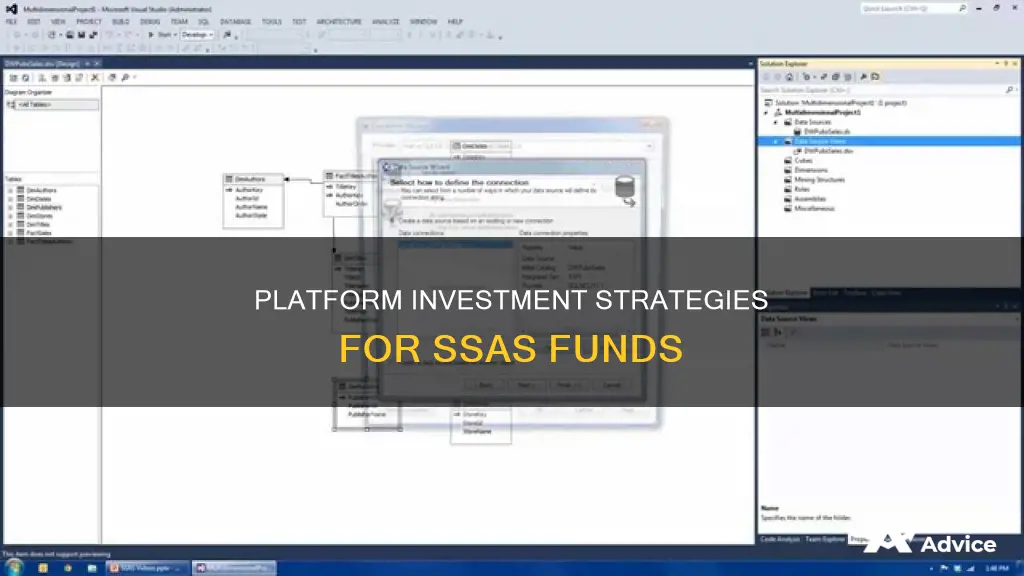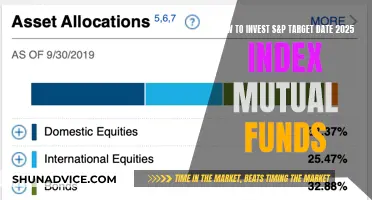
A Small Self-Administered Scheme (SSAS) is a self-invested occupational pension scheme that offers greater investment flexibility and control. SSAS members can invest in a wide range of assets, including commercial property, and create their own retirement strategies. They can also loan money back to the company and benefit from tax advantages. However, it is important to carefully consider the risks and regulations associated with SSAS investments.
| Characteristics | Values |
|---|---|
| Type of pension scheme | Small self-administered scheme (SSAS) |
| Who can use it | Company directors, senior employees, and family members |
| Control over investments | High control and flexibility over where and how money is invested |
| Investment options | Commercial property, industrial/retail units, regulated collective investments, gilts, fixed interest stocks, direct quoted equities, trustee investment plans, loan back to the principal employer |
| Tax benefits | No tax on income, ability to reclaim tax deducted at source of income, no tax on capital gains, tax relief on contributions, tax-free lump sum benefits, tax-deductible admin fees |
| Minimum investment | No minimum, but fees will be charged by the SSAS provider |
| Number of members | No limit, but SSAS tends to be relatively small |
What You'll Learn

Invest in commercial property
A Small Self-Administered Scheme (SSAS) is a self-invested occupational pension scheme that is a popular choice for those seeking increased flexibility and control over their pension funds. It is a corporate pension, regulated by HMRC and The Pensions Regulator, and is established by limited companies for their directors, senior employees and family members.
A SSAS pension can be used to invest in commercial property, and this is one of the most common reasons for establishing one. Commercial property investments can include the property occupied by the sponsoring company, an unconnected third party, or wider commercial portfolios.
There are several benefits to investing in commercial property through a SSAS:
- Any income received from the property, such as rent, will be tax-free.
- If the property is later sold, any capital gain will not be taxed.
- Multiple scheme participants and family members can pool their money into a single SSAS to buy the property.
- The assets held by the pension are generally protected from claims of personal or business creditors.
- Rental income can be paid back into the scheme, growing your pension's value directly.
- You are in control of what you do with the property. You may choose to rent it out to a third party or to your own business.
It is important to note that some investments, such as commercial property, can be harder to sell than others, and there may be additional transaction, running and set-up costs involved.
Pure Alpha Fund: Strategies for Investing and Maximizing Returns
You may want to see also

Invest in a business
A Small Self-Administered Scheme (SSAS) is a self-invested pension scheme established by limited companies for its directors, senior employees, and family members. SSASs are regulated by HMRC and The Pensions Regulator and are a great way to invest in your business in a tax-efficient manner.
If you are a company director, you can access your pension funds at any age and invest them in any HMRC-allowable investments. This includes investing in your business.
Loans to the company:
As a company director with a SSAS, you can take out loans from your pension fund and lend them to your company. This can provide funding for residential property-related investments, such as property deposits or refurbishment costs. It's important to note that these loans are regulated by HMRC rules, which must be adhered to.
Purchase of business premises:
You can use your SSAS to buy your business premises, which can provide tax benefits. For example, the rent received by the SSAS is not liable for income tax or capital gains, and the rent paid by the company is an allowable business expense, reducing the year-end tax bill.
Business growth strategies:
The 'loanback' facility is a strategy where you can draw on SSAS funds up to a maximum of 50% of their combined value to loan to your business. This can be a great way to access tax-free money for your company and is often cheaper than taking out a loan from a bank.
Pooling pensions:
You can pool your pensions with other company directors or family members to give you a larger fund for investments. This is often done when a large acquisition is made, such as purchasing a freehold property to run the business from.
Tax relief and benefits:
Contributions to your SSAS should attract tax relief, and lump-sum benefits payable on death and at retirement are usually free of all taxes, including inheritance tax. Additionally, fees can be paid by the company, which may qualify as a tax-relievable business expense, further reducing tax obligations.
It's important to note that not all SSAS providers allow investments into businesses, so it's crucial to check the rules of your specific SSAS provider before making any investment decisions.
A Guide to Investing in Sundaram Mid Cap Fund
You may want to see also

Invest in gold
Gold is a popular investment choice for those looking to protect their wealth over the long term. Here are some ways you can invest in gold through a SSAS pension:
Invest in Physical Gold
You can invest in physical gold such as gold bars, coins, or jewellery. Gold bullion is the most common form of physical gold investment, with bars typically ranging from a few grams to 400 ounces. The current gold price is around $1,900 per ounce, making gold bullion an expensive investment option. It's important to use a reputable dealer and consider the additional costs for storage and insurance. Gold coins, including collectible options like South African Krugerrands and American Gold Eagles, are another popular choice, though their price may not always align with their gold content.
Another way to gain exposure to the gold market is by investing in the stocks of companies that mine, refine, and trade gold. Some popular options include Newmont Corp. (NEM), the world's largest gold mining company, and Barrick Gold Corp. (GOLD), a gold mining giant operating in 13 countries. Franco-Nevada Corp. (FNV) is unique in that it buys the rights to royalties from other gold miners without owning any mines itself. Keep in mind that these stocks are correlated with gold prices but are also influenced by each company's profitability and expenses.
Gold Exchange-Traded Funds (ETFs) and Mutual Funds
Gold ETFs and mutual funds offer exposure to gold's long-term stability while providing more liquidity than physical gold and more diversification than individual gold stocks. Examples include the SPDR Gold Shares ETF (GLD), which holds physical gold and deposit receipts, and the VanEck Vectors Gold Miners ETF (GDX), a passively managed fund tracking a basket of gold mining and refining company stocks. Gold mutual funds, like Franklin Templeton's Gold and Precious Metals Fund, are actively managed by professionals but often come with relatively high expense ratios.
Gold Options and Futures Contracts
The riskiest way to invest in gold is through options and futures contracts, which are derivatives based on the price of gold as the underlying asset. These speculative investments require active monitoring and carry a high degree of leverage, making them unsuitable for beginners.
When investing in gold through a SSAS pension, it's important to ensure that the gold meets the required standards. For example, HMRC requires gold in pensions to be securely vaulted, held in bar form, and have a purity of not less than 995 thousandths.
Additionally, it's worth noting that profit made on gold investments within a SSAS account is free from income tax.
Bond Funds: Best Time to Invest and Why
You may want to see also

Invest in stocks and shares
Investing in stocks and shares is a traditional route for pension funds. However, this doesn't mean you can only invest in stocks and shares via traditional pensions. There are still many advantages to switching to a self-administered scheme, even if you wish to invest in stocks and shares yourself.
A SSAS scheme is a self-invested occupational pension scheme established by limited companies (and sometimes partnerships) for its directors, senior employees and family members. It offers more control and flexibility over where and how money is invested.
Switching to a SSAS scheme, and investing in stocks and shares can be a very successful SSAS strategy. Many people choose to diversify by switching to a SSAS and only investing a portion of the funds in stocks and shares, with the rest invested elsewhere.
As with other asset classes, profits made by your stocks and shares investments are free from income tax within the SSAS account. In addition, as a SSAS is managed by you, the company director, a SSAS can be aligned with your business to create extremely tax-efficient strategies to save tax for you, your company and your retirement funds.
If you are looking to achieve greater control over and growth from your existing or frozen pension accounts, a SSAS offers a viable solution. Its flexibility allows you to make multiple investments, whether you’re looking to invest in stocks and shares, property, gold or other asset classes.
Closed-End Investment Funds: Where and How to Trade
You may want to see also

Invest in green initiatives
Investing in green initiatives is an increasingly popular option for those with SSAS pensions. This is because SSAS pensions offer more flexibility and control over pension funds than other pension schemes.
Green investments are responsible investments in companies that provide or support environmentally friendly products, services and projects. This could include sustainable energy, green energy stocks, recycling, power generation projects, wind power, solar energy, green transportation, organics, and many more investment opportunities.
If you are a company director, you can access your pension funds at any age and invest them at your own discretion in any HMRC-allowable investments. This means that you can use your SSAS pension to invest in green initiatives.
- Establish your personal financial goals: Before investing, it's important to understand your objectives, such as retirement savings, funding your child's education, or buying a home. This will help you choose the right green investments that align with your values and risk tolerance.
- Understand the risk-return trade-off: Green investments, like any other investment, come with a certain level of risk and potential return. It's crucial to understand this trade-off when selecting investment options.
- Assess your risk tolerance: Your risk tolerance is influenced by factors such as age, financial situation, and investment horizon. Evaluating your risk tolerance will help you make informed decisions when allocating funds to green investments.
- Use Environmental, Social, and Governance (ESG) criteria: ESG criteria can help you identify green and sustainable companies to invest in. ESG factors assess a company's commitment to sustainability, social responsibility, and ethical governance, allowing you to make more informed investment decisions.
- Consider different investment options: There are various green investment options available, such as stocks of environmentally friendly companies, green bonds, Exchange-Traded Funds (ETFs), Mutual Funds, green real estate, and infrastructure projects.
- Diversify your portfolio: Diversification is important to minimise risk. Include a mix of traditional assets, such as stocks, bonds, and cash, in your portfolio, along with green investments. This will help ensure your portfolio is resilient to market fluctuations and unforeseen events.
- Monitor your investment performance: Regularly assess the financial performance of your green investments to ensure they are meeting your financial goals and expectations.
- Evaluate the environmental and social impact: In addition to financial performance, track key performance indicators (KPIs) such as greenhouse gas emissions reduction, water usage, or community engagement initiatives to ensure your investments align with your values and impact goals.
- Work with financial professionals: Consider working with a financial advisor who has experience with green investments. They can help you navigate the complexities of sustainable investing and recommend suitable investment options based on your goals and risk tolerance.
By following these guidelines and staying informed about green investment trends, you can make strategic decisions when investing in green initiatives through your SSAS pension.
Money Market Funds: When to Invest for Maximum Returns
You may want to see also
Frequently asked questions
SSAS stands for Small Self-Administered Scheme. It is a self-invested occupational pension scheme established by limited companies for its directors, senior employees, and family members.
SSAS pensions have a broader range of investment options than traditional pensions. Members can pool their money, boost their buying power, and choose from a wider range of investments including commercial property. SSAS pensions also offer greater control over contributions and how benefits are paid out in retirement.
You can set up a SSAS with any provider of your choice. However, it is recommended that you consult an expert to understand how a SSAS pension can work for your specific circumstances.







